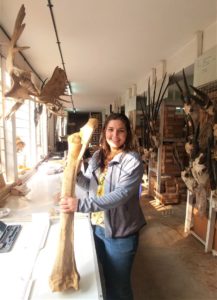The past to guide future of conservation
AgriLife Research looks to ecological, biological trait changes over millennia
Deep dives into the ecological and biological past could provide direction for the future of conservation.

A Texas A&M AgriLife Research scientist is looking at changes in mammalian and reptilian traits as far back as 7.5 million years to measure when and why animal communities changed. The research looks to identify the correlation between ecological changes to the environment and subsequent impacts on communities of species, including influenced adaptations.
Michelle Lawing, Ph.D., a quantitative ecologist and associate professor in the Department of Ecology and Conservation Biology, principal investigator for the Texas A&M University-led project, said the three-year $1.2 million collaborative study hopes to determine how paleobiology can inform conservation strategies regarding ecosystem function, habitat and species protection.
Lawing is collaborating with several other principal investigators on this project, including Jenny McGuire, Ph.D., assistant professor, School of Biology and School of Earth and Atmospheric Sciences at the Georgia Institute of Technology; Jason Head, Ph.D., professor, Department of Zoology, University of Cambridge, England; and Fredrick Manthi, Ph.D., professor, National Museums of Kenya.
Lawing was the recipient of $516,000 and McGuire is receiving more than $299,000 from the National Science Foundation, while the National Environmental Research Council funded additional elements of the research.
Lawing said the study will focus on land-dwelling mammals and reptiles. She hopes to establish how traits are balanced within ecosystems and how environmental changes can shift the balance for or against those traits. The study will also explore the future of conservation by identifying and/or evaluating traits that are more susceptible to changes or imbalances in the ecosystem.
“By looking to the past, we hope to find how traits may have been impacted by changes in environment or other disruptions,” she said. “We know there is a delicate balance for some traits, and some are more robust to change.
“By using multiple trait types and species groups, we can measure how disruptions impact those different trait balances and investigate the trait-environment relationship on a deeper level than has been done before. Understanding how changes in these relationships contributed species movement, reorganization or extinction will tell us more about the past, but it will also be a valuable tool to inform future conservation.”
Manthi said the project will also help train students in related scientific fields and establish another generation of researchers prepared for international engagement and collaboration.
Future conservation guided by the past
Conservation paleobiology is proving important to understanding how ecological changes can impact plants and animals over time, Lawing said.
Organisms interact with their environment via functional anatomical, behavioral and physiological traits. Scientists are increasingly aware that habitat loss, climate change and species losses impact organisms based on how those traits react to change.
Whether behavior or physiological changes occur in the short-term or over millennia, studying the diverse ecosystems that support vertebrate life is crucial to scientists’ ability to forecast biotic responses to future changes, Lawing said.
Traits in hypsodont mammals like prehistoric grazers, North American bison and cattle grazing on the Great Plains are a good example of this animal-ecosystem relationship, she said. Hypsodonts have tall teeth, allowing them to eat gritty grasses that wear down teeth over the life of the animal.
Without this tall tooth trait, grazers would wear down their teeth quickly and starve, and without grazers and other herbivores, the grassland ecosystems would become unbalanced and change, Lawing said. So, the loss of traits can have a cascading impact on the entire ecosystem, especially in animals and plants with traits that make them better suited or more susceptible to environmental changes.
This international collaborative project will use fossils to reconstruct the onset, tempo and mode of changes in the African mammalian and reptilian vertebrate ecosystem over millions of years. The fossil collection at the National Museum of Kenya will play an important role in the research because Eastern Africa is where humans evolved as hunter-gatherers, and there is a very long record of human and environment dynamics.
“From these records, we can determine the timing, rate and degree of human-mediated disruptions to the balance between traits and environment,” Lawing said. “Understanding how each disruptive element might have impacted certain traits throughout time will give us a good idea how balance unfolded and how we might mitigate disruptive activities in the future.”


